Indian Embroidery Research
Chapter 5
I already had several examples of Indian embroidery and shisha but had a great
time searching out some extra pieces. My collection for research comprised the
following:
Sketchbook page 10
Cushion assembled from old metal embroidered saris. The cushion is 42
cm square.
The section detail below is 13cm x 10cm.
Detail below is 14cm x 8cm
Detail below is14cm x 7cm
Small finely stitched shoulder bag with shisha mirrors bought from Trade Aid.
Stitched area is 16cm x 11cm. Tassels approx 1.5cm in length, tiny 8-10mm
mirrors.
The sales label states 'Bag Kothali' and research indicates that Kothali is a
picturesque village situated in Chikodi taluk of Belgaum District of Karnataka.
It s the birthplace of the revered Jain saint Acharya Deshbuhushan Maharaj.
Karnataka is famous for its silk work. I forgot to note where this
information came from but I have a suspicion I found it on the internet.
Bag assembled from old cotton shisha embroideries purchased from an Indian gift shop in Wellington. I deconstructed this bag and shared the pieces with Eila and Karen. Main section of bag measures 33cm x
34cm. Stitching is worked mainly in cotton, the work is worn but from stitching remaining it appears that it was quickly and roughly done.
Small bag with square mirrors stitched in wool on a cotton ground. I am guessing that this
has been stitched for the tourist trade. Purchased at a little Indian shop
in Auckland. I hadn't seen square mirrors used previously. Again this
appears to have been worked quickly using a basic design. Stitched area is 15cm
x 14.5cm
Drawings and sketches based on the above examples.
Sketchbook page1
Sketchbook pages 2 & 3
Sketchbook pages 4 & 5
Sketchbook pages 6, 8 & 9
Sketchbook page 7
Spot sampler of traditional Indian embroidery stitches. Techniques from
The Techniques of Indian Embroidery, Anne Morrell; Ethnic Embroidery
of India, Usha Shrikant; Designs for a Lifetime, Usha Shrikant. Molly
purchased Usha Shrikant's books from her at a seminar she attended in the USA.
They are full of designs, background information on different tribal styles and
stitching diagrams.
Patterns drawn on ground (lining recycled from the cotton sari bag purchased in
Wellington) using lemon juice on a satay stick, stitched using
coton a broder 16 thread and mostly based on designs in research samples.
24cm x 25cm
Detail
Detail showing tassels made from fabric strips, beads and coton a broder and stranded cotton
Chapter 7 - Contemporary Shisha Ideas
Contemporary Shisha Ideas (32cm x 16.5cm). Lemon juice on satay stick
used for the background design. From top "shisha" used are: glass
triangles, 1 cent coins, spiral paper clips, buttons, metal shapes (used for
binding off files), paua shell, folded chocolate wrappers (silver and gold),
tomato paste tube, fragments of shiny plastic, small flat pebbles from Birdlings
Flat on the way to Akaroa, glass shisha stitched between two layers of fabric, folded milk bottle seals, folded
textured foil, corrugated foil. This exercise was a fun challenge - first of all
finding "shisha" and then working out different methods of attaching them. By
the time I had filled up the original piece of fabric and then added another
section I thought I had better stop and go on to something else!
Machine Stitchery to Apply Shisha - I stamped
the background and then had the challenge of machine stitching my "shisha" down
without breaking needles which I discovered was easier to do than I thought it
would be. Stitching round and round the 2 cent coins with a very
loose bobbin tension proved most effective and I was surprised how even it
turned out. The paua and the glass triangles were a challenge to hold in
place as I did the first stitches (ensuring my fingers were kept out of the
way). I am pleased with how these samples worked out. (14cm x 14cm)
Combined Hand and Machine Stitching - Stamped
background, free machine stitch to form flower shapes, cable stitch, shisha
handstitched to centre of cable stitched flowers. (12.5cm x 11cm)
Chapter 6
Stamps made from foam, string, paper string and card and broken satay
sticks glued to card based on patterns on research items. Various sizes from
11cm x 10cm to 2cm x 4cm
Rubbings using above stamps/blocks
Crayons on soft grey paper - this became too messy with too many overlays
(A4)
Combinations of various rubbings
Sheet 1
Sheet 2
Sheet 3

Sheet 4
Although I like doing rubbings I was not particularly happy with any of the
results at the time I did them. Putting them together now though I can see
some possibilities for further development - B on sheet 1, A on sheet 2, A on sheet 3
Folding, cutting and reassembling
Sheet 5 (A4)
Sheet 6 (A5)
Sheet 7 (CD size according to the computer when I was cropping it)
The above 2 pages (6 & 7) spent so long sitting on my workdesk that they have faded
badly - this unfortunately hasn't helped the designs which weren't particularly
successful even when they were fresh.
Sheet 8 (A4) - Lemon juice applied with a satay stick used as a discharge on
dyed tissue paper. I enjoyed this exercise much more than the rubbings and
am much more pleased with the result. I like the blobs and randomness of
the marks which give the designs much more of a personality. Rather like
blind or other hand drawing. The two left hand designs originated from the old
cotton sari bag and the other three from the Trade Aid bag.
Sheets 9 - 11 Sgraffitto - Layers of crayon with designs scratched through the layers using the blunt
end of a satay stick. This was a fun exercise even though some colours blended
rather than layered (white especially). I like the aged effect of these.
Each of the following 3 are approximately 10cm square. Photographing has drained
the subtleness of the colouring from these, especially the middle example which
is a soft goldy/white in reality.
Sheet 9
Sheet 10
Sheet 11
Just out of interest I am including below the Indian themed sampler cushion
which I started in a class with Anthea Godfrey and Margaret Nicholson in Dunedin
more years ago than I care to remember and which I finally completed about 18
months ago during an intensive period of finishing some of my UFOs (unfinished
objects). We had been presented with photocopies of Indian embroidery
samples and worked from these to sort out a design. Margaret Nicholson
taught us how to do the ornue section (the bottom strip) and most of the beads I
had dyed myself in the class (messy but with fascinating results).
Bayeux Tapestry Study
Sketchbook page 30
Sketchbook pages 31 & 32
Sketchbook page 33 - the postcard was sent to me by a friend after visiting the
tapestry.
My attempt at traditional Bayeux Stitch using wool and similar colours as in the
original. (Stitching 8cm x 4.5cm) Enjoyable to stitch - I made up
the design as I went along.
This sample is worked after Jan Messent's example in
Stitch with the Embroiderers' Guild No 5, June/July 2000, p.14 (approx 6cm
square). Fun to stitch with a variety of non-traditional threads - the
planned square distorted a little with the stitching.
Chapter 5
I already had several examples of Indian embroidery and shisha but had a great
time searching out some extra pieces. My collection for research comprised the
following:
Sketchbook page 10
Cushion assembled from old metal embroidered saris. The cushion is 42
cm square.
The section detail below is 13cm x 10cm.
Detail below is 14cm x 8cm
Detail below is14cm x 7cm
Small finely stitched shoulder bag with shisha mirrors bought from Trade Aid.
Stitched area is 16cm x 11cm. Tassels approx 1.5cm in length, tiny 8-10mm
mirrors.
The sales label states 'Bag Kothali' and research indicates that Kothali is a
picturesque village situated in Chikodi taluk of Belgaum District of Karnataka.
It s the birthplace of the revered Jain saint Acharya Deshbuhushan Maharaj.
Karnataka is famous for its silk work. I forgot to note where this
information came from but I have a suspicion I found it on the internet.
Bag assembled from old cotton shisha embroideries purchased from an Indian gift shop in Wellington. I deconstructed this bag and shared the pieces with Eila and Karen. Main section of bag measures 33cm x
34cm. Stitching is worked mainly in cotton, the work is worn but from stitching remaining it appears that it was quickly and roughly done.
Small bag with square mirrors stitched in wool on a cotton ground. I am guessing that this
has been stitched for the tourist trade. Purchased at a little Indian shop
in Auckland. I hadn't seen square mirrors used previously. Again this
appears to have been worked quickly using a basic design. Stitched area is 15cm
x 14.5cm
Drawings and sketches based on the above examples.
Sketchbook page1
Sketchbook pages 2 & 3
Sketchbook pages 4 & 5
Sketchbook pages 6, 8 & 9
Sketchbook page 7
Sketchbook page 10a
Spot sampler of traditional Indian embroidery stitches. Techniques from
The Techniques of Indian Embroidery, Anne Morrell; Ethnic Embroidery
of India, Usha Shrikant; Designs for a Lifetime, Usha Shrikant. Molly
purchased Usha Shrikant's books from her at a seminar she attended in the USA.
They are full of designs, background information on different tribal styles and
stitching diagrams.
Patterns drawn on ground (lining recycled from the cotton sari bag purchased in
Wellington) using lemon juice on a satay stick, stitched using
coton a broder 16 thread and mostly based on designs in research samples.
24cm x 25cm
Detail
Detail showing tassels made from fabric strips, beads and coton a broder and stranded cotton
Chapter 7 - Contemporary Shisha Ideas
Contemporary Shisha Ideas (32cm x 16.5cm). Lemon juice on satay stick
used for the background design. From top "shisha" used are: glass
triangles, 1 cent coins, spiral paper clips, buttons, metal shapes (used for
binding off files), paua shell, folded chocolate wrappers (silver and gold),
tomato paste tube, fragments of shiny plastic, small flat pebbles from Birdlings
Flat on the way to Akaroa, glass shisha stitched between two layers of fabric, folded milk bottle seals, folded
textured foil, corrugated foil. This exercise was a fun challenge - first of all
finding "shisha" and then working out different methods of attaching them. By
the time I had filled up the original piece of fabric and then added another
section I thought I had better stop and go on to something else!
Machine Stitchery to Apply Shisha - I stamped
the background and then had the challenge of machine stitching my "shisha" down
without breaking needles which I discovered was easier to do than I thought it
would be. Stitching round and round the 2 cent coins with a very
loose bobbin tension proved most effective and I was surprised how even it
turned out. The paua and the glass triangles were a challenge to hold in
place as I did the first stitches (ensuring my fingers were kept out of the
way). I am pleased with how these samples worked out. (14cm x 14cm)
Combined Hand and Machine Stitching - Stamped
background, free machine stitch to form flower shapes, cable stitch, shisha
handstitched to centre of cable stitched flowers. (12.5cm x 11cm)
Chapter 6
Stamps made from foam, string, paper string and card and broken satay
sticks glued to card based on patterns on research items. Various sizes from
11cm x 10cm to 2cm x 4cm
Rubbings using above stamps/blocks
Crayons on soft grey paper - this became too messy with too many overlays
(A4)
Combinations of various rubbings
Sheet 1
Sheet 2
Sheet 3
Sheet 4
Although I like doing rubbings I was not particularly happy with any of the
results at the time I did them. Putting them together now though I can see
some possibilities for further development - B on sheet 1, A on sheet 2, A on sheet 3
Folding, cutting and reassembling
Sheet 5 (A4)
Sheet 6 (A5)
Sheet 7 (CD size according to the computer when I was cropping it)
The above 2 pages (6 & 7) spent so long sitting on my workdesk that they have faded
badly - this unfortunately hasn't helped the designs which weren't particularly
successful even when they were fresh.
Sheet 8 (A4) - Lemon juice applied with a satay stick used as a discharge on
dyed tissue paper. I enjoyed this exercise much more than the rubbings and
am much more pleased with the result. I like the blobs and randomness of
the marks which give the designs much more of a personality. Rather like
blind or other hand drawing. The two left hand designs originated from the old
cotton sari bag and the other three from the Trade Aid bag.
Sheets 9 - 11 Sgraffitto - Layers of crayon with designs scratched through the layers using the blunt
end of a satay stick. This was a fun exercise even though some colours blended
rather than layered (white especially). I like the aged effect of these.
Each of the following 3 are approximately 10cm square. Photographing has drained
the subtleness of the colouring from these, especially the middle example which
is a soft goldy/white in reality.
Sheet 9
Sheet 10
Sheet 11
Just out of interest I am including below the Indian themed sampler cushion
which I started in a class with Anthea Godfrey and Margaret Nicholson in Dunedin
more years ago than I care to remember and which I finally completed about 18
months ago during an intensive period of finishing some of my UFOs (unfinished
objects). We had been presented with photocopies of Indian embroidery
samples and worked from these to sort out a design. Margaret Nicholson
taught us how to do the ornue section (the bottom strip) and most of the beads I
had dyed myself in the class (messy but with fascinating results).
Bayeux Tapestry Study
Sketchbook page 30
Sketchbook pages 31 & 32
Sketchbook page 33 - the postcard was sent to me by a friend after visiting the
tapestry.
My attempt at traditional Bayeux Stitch using wool and similar colours as in the
original. (Stitching 8cm x 4.5cm) Enjoyable to stitch - I made up
the design as I went along.
This sample is worked after Jan Messent's example in
Stitch with the Embroiderers' Guild No 5, June/July 2000, p.14 (approx 6cm
square). Fun to stitch with a variety of non-traditional threads - the
planned square distorted a little with the stitching.


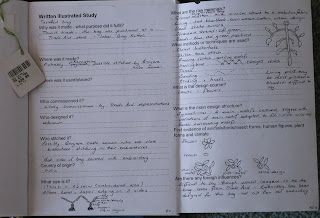
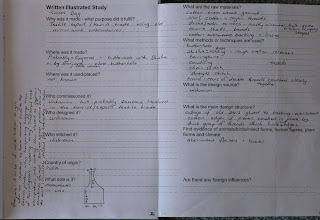



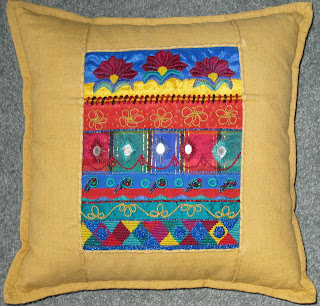
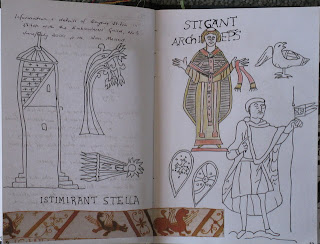

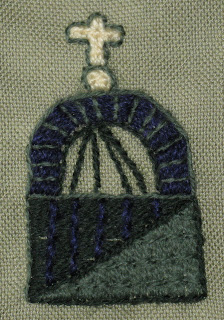

No comments:
Post a Comment